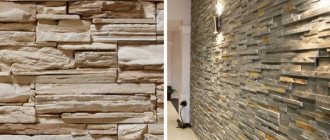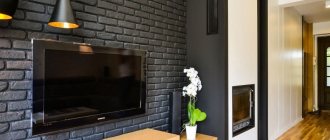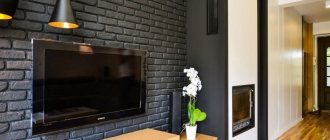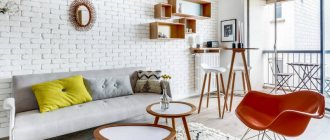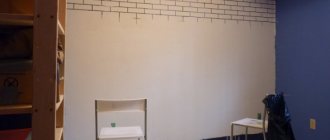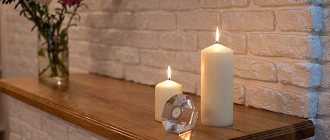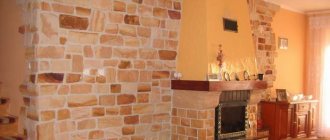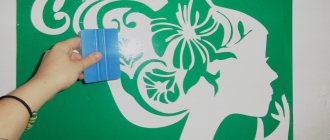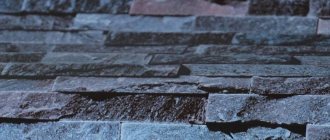Natural elements in an apartment, house or office are an effective design solution that will add a special touch to any room. Moreover, it is not necessary to create a single interior style; individual inserts and eclecticism are acceptable. For example, a wall made of “wild stone” looks interesting in a nautical-style room or a high-tech kitchen. But even for a classic living room there is a use for such an element. And, as for lofts, ethnic and Scandinavian interiors, tiles will become the main forming material in them. Today she is in trend. Laconic design and rough, but at the same time, elegant simplicity are becoming fashionable, and with the improvement of production technologies to imitate natural materials, decorative stone tiles look realistic.
The popularity of this design supports the fashionable trend of leading a healthy lifestyle and ecology.
Design features with gypsum tiles
The essence of using gypsum tiles when decorating walls is to obtain a beautiful relief. And if you consider that in this way you can imitate stone and brick masonry, then by using it you can decorate rooms in almost any style. At the same time, it is not at all necessary to cover all the walls with such tiles. After all, this is a type of decoration, and decor always looks better when served in doses.
Spacious loggia with white plaster walls
Let's look at the photo at how gypsum tiles can be used in the interior of a particular room.
Kitchen, bathroom
As in any other room, when decorating the walls of the kitchen, you also need to focus on style. Most often, a brick or stone tile option is used here, which can be used to decorate a work wall or highlight a dining area.
Surface painting is best done with water-based silicone paint, which protects the finishing surface from dirt and allows you to not only wipe the surface, but also wash it with a cleaning agent. It is better not to use relief tiles on a working wall, as it is then more difficult to remove dirt from them.
Gypsum tiles in the kitchen interior
Gypsum tiles in the kitchen - dining area
Brick tile backsplash
As for bathrooms, gypsum tiles are used less often. In any case, for small apartment bathrooms that do not have windows for ventilation, such a design is impractical and it is better to use ceramic tiles in the decoration. But in private houses, where the size of the bathroom is no less than a bedroom, or even consists of two walk-through rooms, gypsum tile finishing will also look great.
Finishing one wall in the wash area
Combination of gypsum cladding and painting
Finishing the toilet with white gypsum tiles
Hallway
In the design of the hallway you can use not only stone or brick tiles, but also options with a 3D effect. There are usually no blank walls in this room, since they all have doorways leading into the rooms. Provided that beautiful doors are installed in them, and, if possible, nice wall lamps, the appearance of the walls, lined with, for example, white tiles, will be inimitable.
A similar design can be used as a basis when you need to decorate a zoning partition in a studio apartment, separating the hallway from the living space.
Gypsum tiles in the interior of the hallway - studio apartment
Combination of gypsum tiles with wallpaper in the hallway
Finishing corner areas and partitions with stone
Imitation of brickwork on one wall
White color compensates for the lack of natural light in the hallway
Imitation stone with cut noodles
Design in loft style
Adults and children's bedrooms
The bedroom, including the children's room, can be either an independent room or an area allocated in one large studio. With the help of relief tiles it is very convenient to carry out visual zoning - including when you need to allocate a zone in the bedroom itself (for a child, a play or study zone, for an adult, a work zone).
Decoration of brick walls and partitions
Covering a fragment at the head of the bed
Emphasizing the sleeping area
Living room
The main attention in the living room is drawn to the wall on which the TV hangs, because it is visible from everywhere. Either this is a wall in which a working or decorative fireplace is equipped, since a guest area with upholstered furniture standing in a semicircle is usually arranged around it
It is these walls that are finished with gypsum tiles - or, as they are also called, decorative (Roman) stone. This finish looks very harmonious on a wall free of furniture, on which there are symmetrical niches.
You can see how gypsum tiles look in the living room interior in the photos below:
Finishing a rough fireplace with gypsum tiles
Accent wall in the fireplace area
Combining two masonry textures with a whitewashed surface
White bricks in the wall decoration with a decorative fireplace
Design of the television zone
Wall with symmetrical niches-cabinets, lined with stone-effect tiles
Option for combining stone wall decoration with interior panels
Other ways to imitate brickwork
False bricks can be obtained by extruding them from flat ceiling tiles made of polystyrene foam without a pattern.
For false bricks, flat polystyrene foam tiles without a pattern are suitable. For our purposes, you can use any of its sides. The optimal size of the “stone” is 7/15 cm. If you increase the proportions, the wall will look unnatural. The process of making “stones” is simple: we squeeze them out of the ceiling tiles.
First, using a gel pen, apply markings to the polystyrene foam. Please note that to maintain the correct shape you need to make seam allowances. Next, take a toothpick and, tilting it, press straight lines along the ruler with slight pressure. Then you need to make a special device: a crusher. To do this, use metal scissors to cut out a flat tin strip from the lid of a tin can, and cut off both sides from one edge of it so that you get a “sting” 2 mm wide. Using this device we press our bricks along the lines in the ceiling tiles.
We glue the finished products with our own hands onto the desired part of the wall. We use ceramic tile adhesive as a binder. There is no need to fill the seams with plaster. The gaps between the “stones” need to be made very small: 1-1.5 mm. After finishing the gluing work, the bricks need to be painted. We try to apply as much paint as possible into the gaps, thereby creating an imitation of brickwork.
Popular articles Household cleaning products
wooden bricks
Using imitation brickwork, you can achieve the maximum decorative effect with a minimum thickness of the coating.
This method is quite simple: with our own hands we make the required number of wooden dies of the same size and rectangular shape. If you sand them on one side, you get a stylish, beautiful wall surface with an imitation of brickwork. Work on installing the “stones” begins with markings. Along this horizontal line, starting from opposite corners of the wall, we install the bricks, keeping an equal distance between them corresponding to the selected seam thickness.
First, we lightly nail the wooden dies to the wall with thin nails. When the entire row is laid out, we will drown them in plaster. When all the rows are completed, we will cover the ends of the brickwork with wooden slats. Then we paint the wood with our own hands in the desired color. It is recommended to make the seams much darker. Over time, the wall can be refreshed by repainting it or covering it with wood varnish. This imitation brick wall is very durable.
tile adhesive bricks
For the manufacture of parts, any tile adhesive is used, which is sold in the form of a dry mixture. It needs to be diluted with water until it becomes a very thick sour cream. It is best to use a white composition. Then we divide the whole mass into 3 parts, adding a little paint to each of them.
It is important that the paint differs in shade in each part
Mix the mass in each pile like dough. We will get a mass with beautiful stains. Roll it out into a “pancake” and cut bricks of the same size. We lay them out to dry. We do this until we collect the required number of “stones”. We glue it to the wall using the same tile adhesive. Fill the seams with a compound painted in a darker color. At the end, the wall surface can be covered with several layers of varnish.
Types of stone-effect tiles for exterior and interior decoration
Decorative stone is offered on the building materials market in Moscow and other cities for both exterior and interior decoration. Depending on its purpose, ingredients of varying degrees of strength are added to the composition of the plates.
Exterior stone must withstand higher loads, so before purchasing, you should carefully study the characteristics of the selected material. For exterior decoration, you can glue decorative tiles under various types of natural stone:
concrete;
acrylic;
gypsum;
quartz;
porcelain stoneware;
conglomerate.
Not only walls, but also door slopes can be finished with decorative tiles.
Clinker
The chemical composition of the material allows it to be used in regions with low temperatures during the cold season. In addition to frost resistance, the material also has other characteristics:
- attractive appearance;
- various shapes;
- large selection of colors and textures;
- strength;
- long service life;
- environmental Safety;
- UV resistance.
However, the cost of such material is higher than that of ceramic analogues.
The only drawback of clinker products is its cost. Such tiles are much more expensive than ordinary ceramic tiles, but over long-term use, clinker tiles pay for themselves.
Tsokolnaya
The artificial slab for basement finishing has technical characteristics similar to high-strength basement bricks. The material is strong, frost-resistant, moisture-resistant and durable. The appearance of the product does not deteriorate with prolonged exposure to sunlight and weather conditions. The integrity of artificial stone is not lost due to sudden temperature changes. External finishing reliably protects the walls, basement and foundation of the building from negative external influences.
Flexible
Innovative developments have made it possible to produce flexible tiles for cladding the external and internal walls of a house. Such products have an attractive appearance, can be easily installed without the help of builders, and also protect surfaces from mechanical stress. A special feature of such tiles is the possibility of laying not only on flat surfaces, but also on the corners of the building and on rounded structural elements. It does not deform and fits tightly to each other.
Facade
To imitate expensive facade bricks, a decorative variation of crushed or “torn” stone of increased strength is widely used.
Facade tiles have the following characteristics:
- resistance to mechanical damage;
- safety;
- resistance to weathering and temperature changes;
- ease of installation.
The color scheme of the facing tiles is selected depending on the overall exterior.
Stone effect tiles for interior decoration
In addition to façade options, the range of products offered by manufacturers also includes plates for interior cladding. They are lighter and less durable, but at the same time visually attractive and more varied in design.
Decorative stone-like tiles can be glued to interior walls using various adhesives. They are selected depending on the quality of the finishing material itself. Wall tiles can be made from ceramics, gypsum, porcelain stoneware and polyvinyl chloride.
Ceramic
The classic version of cladding in the form of ceramic masonry does not lose its relevance. It is durable and strong, and is used to decorate the interiors of the living room, kitchen, bathroom and hallway.
Porcelain stoneware
Ceramic options also include porcelain tiles, which are based on clay, feldspar, minerals and coloring pigments. The material does not absorb moisture and can withstand temperature changes. The main characteristics of the material are reliability and strength.
Plaster
The finishing material made of gypsum is durable and aesthetically pleasing. The variety of textures allows you to use this cladding to decorate living rooms, loggias and balconies. Wall tiles are perfect for finishing fireplaces. However, to protect against fire, the tiles should be equipped with thermal insulation panels.
PVC
The lightest PVC panels are durable, cheap and easy to install. They are easy to maintain and can be reused.
Main types of wild stone
Wild stone in its diversity is divided as follows:
- sandstone _ The most common type of natural material, which includes carbonate, quartz, and expanded clay. The color of the material ranges from gray to brown. The material is quite hard, has good moisture resistance, and a low level of porosity. There is torn sandstone, which is easy to install and assumes a chaotic arrangement of elements;
- boulders . Stones whose shape is explained by the influence of water over hundreds of years on natural material. The material has increased wear resistance, durability, and strength. The elements have smooth stripes on a gray background. There are boulders of different colors: light gray, dark gray, yellow and even light burgundy. When laying stones of different colors, a high decorative design is ensured. For facing work, the material is sawn so that the inner side is flat;
- sea pebbles. Natural remains of rocks are flat stones polished with water, which are widely used not only for cladding facades, but also for solving design ideas in landscape design;
- meotis (shell rock). It is a fibrous structure with a capillary structure, which consists of ancient deposits of mollusk shells. The extraction of natural material has a separate territory: deposits of this rock cannot be found everywhere. In terms of physical properties, shell rock is similar to ceramics. Porous meotis easily withstands weather conditions, is quite durable, and has an unusual color.
Since natural stone is an expensive material, manufacturers of finishing materials offer a wide range of artificial stone , which in terms of physical characteristics and visual similarity to wild ones do not have significant differences .
Gypsum stone tiles in the interior of the house
A high-quality imitation of natural stone is gypsum tiles. The material is made from gypsum-polymer mass and has low frost resistance, therefore such stone-like finishing tiles can only be used for interior work.
Properties of gypsum tiles:
- Light weight.
- Hygroscopic - able to regulate the level of humidity in the room, that is, absorb excess moisture and release it if the air is too dry.
- Thin-layer material, thanks to which gypsum stone tiles can be installed even in small apartments, saving precious centimeters of space.
- Gypsum is a natural material, which makes it environmentally friendly.
- Has no smell.
- Does not fade under ultraviolet rays.
- It has heat and sound insulation properties.
- Fire resistant.
Gypsum wall tiles under stone are laid easily and quickly, easy to process, which eliminates the cost of craftsmen and time losses. But you need to remember that the material is flexible, soft and fragile, so you need to work with it carefully.
Which stone is better?
All rocks differ from each other in terms of strength, appearance, resistance to various influences, price and complexity of processing. Most often, limestone, sandstone, slate are used for cladding buildings; granite is the most expensive and difficult to process.
It is very difficult to single out among them the one that can be called the best of all. You need to be guided by your wishes regarding appearance, the possible amount of expenses and other factors. If possible, it is better to buy granite or marble, but if you don’t have enough money for them, then you can buy sandstone.
Sandstone for facade cladding
Advantages and disadvantages
When choosing facade tiles for chipped, “torn” or other stone, you can assume that an unnatural material does not have even the slightest chance of being better. In fact, artificial analogues have a lot of advantages.
There are many advantages of using such a facing material for the facade:
- Resistance to damage and high strength.
- Resistance to temperature differences and all kinds of atmospheric phenomena.
- Environmental Safety.
- Easy to install. Making wall cladding yourself using this material is not difficult. Many people even produce the material themselves using special forms.
- Identical look. Facade tiles perfectly imitate any subtype of real stone. Sometimes it is almost impossible to find the differences between them.
- Long service life. According to manufacturers, stone-look tiles can last more than 100 years.
- Affordable price. Even the most expensive facade tiles with high-quality stone imitation will cost much less when compared with the cost of natural materials. Laying natural stone is quite difficult; it is impossible to do it with your own hands. Professional help will be needed, which will also have to be paid for.
- Natural material can form only one type of surface, but artificial material can be recreated in different variations of the original texture, color and even relief. Decorative characteristics in this case are much more interesting.
- Can be selected for both residential buildings and industrial buildings.
- The tiles are very light, for this reason the foundation does not have to be strengthened.
- Damaged products can be easily replaced with new ones. The parameters of a fake stone are more uniform, and it is much easier to find the necessary material for replacement than to find a product made from natural rock of the same color and structure.
This popular material also has some disadvantages:
- a huge assortment of tile varieties will require knowledge of installation and maintenance methods for this product;
- Some types of material will not allow dismantling and re-installation, so you will have to have a reserve material in case of repair.
Features of plastering work on the facade
Experts believe that the easiest way to make decorative stone is based on a ready-made mixture, but you can prepare the composition yourself. You can get an imitation of any rock or ornamental gem.
Universal cladding for facades, characterized by high durability and aesthetics. External work is carried out in compliance with the technology indicated on the packaging, adjusted for temperature and humidity. Sometimes you have to moisten the surface so that it does not dry out. Overheating in the sun with rapid polymerization is undesirable; it will complicate decoration.
Universal cladding for facades, characterized by high durability and aesthetics.
How to do it yourself, stages of implementation
To reduce repair costs, it is recommended to master all stages of application. It can be used to cover walls and foundations, steps and columns. After application, the relief is extruded with a polymer stamp, then the seams are formed.
To obtain the highest quality coating, use three layers:
- Starting plaster will eliminate all wall defects and prepare the surface; this layer is not leveled.
- The primer layer is applied no earlier than 2-3 hours later, when the base has hardened.
- The covering layer is the surface on which the stone effect is formed, decorating in the way you like.
After application, the relief is extruded with a polymer stamp, then the seams are formed.
Obviously, it is easier to decorate any vertical or inclined surface with an imitation of wild rock using special plaster. This simplifies the processing of spherical, arched and curved shapes, which is difficult when facing with stone blocks. The finished surface is difficult to distinguish from natural granite or basalt, and plaster is much lighter.
Simplified options for facade decoration
“Lighting will create the right mood and emphasize the beauty of the decoration of the facade of the house”
If you are not ready to cover your house with siding, wood, etc. In ways to make his image complete, you can use one or more of the following design moves:
- Bright, beautiful cornices will help you quickly and easily transform the appearance of a building.
- Window frames painted in unusual colors will significantly change the exterior of a country estate. An excellent solution would be to add shutters to them
- Window and door openings, as well as house corners, can be decorated with façade elements such as towers or columns.
in modern facade finishing materials such as painted aluminum are used
In the dark, skillfully organized lighting can become a façade decor. To do this, you need to use wall and hanging lanterns of various designs, LED strips. Lighting will create the right mood and emphasize the beauty of the decoration of the facade of the house. In addition, light will make the area more comfortable and safe. Agree, it is much more pleasant to climb the well-lit steps of the porch or drive into a garage door flooded with light than to stagnate there in complete darkness.
façade cladding with bassoon under brickwork
There is another non-standard option to give the house an unusual look - to hide its walls behind a living facade. The shoots of climbing plants are distributed over a metal mesh specially arranged along the walls. Such a living finish will require careful maintenance. The shoots will need to be trimmed in a timely manner so that they do not entwine the windows, and the plants themselves will need to be watered and protected from pests. This is not particularly problematic in our time, so it’s worth taking note of the idea.
Conclusion
Finishing the facade of a house, no matter how it is done, is additional protection, insulation and decoration for it. As can be seen from the above, the decorating process is not always expensive. You can do a lot yourself by looking at projects on the Internet.
Living in a beautiful, practical house that attracts attention with its unusual exterior is incredibly pleasant, and you should not deny yourself this pleasure!
We decorate the facade with natural stone
After the stone has been selected, purchased, and delivered directly to the construction site, it is sorted, removing too small and fragile pieces from the total. In general, the entire stone is divided into several piles, in which elements of approximately the same size are collected. Next begins the preparation of the facade and its facing with stone. Work should be carried out at positive temperatures so that the base is heated to +5-30 degrees.
Step 1. First of all, the facade is carefully examined. The surface must be durable and dry.
Façade inspection
Step 2. Next, the surface is cleaned of dust and debris using a brush. All major irregularities are eliminated.
Surface cleaning
Step 3. All large cracks are puttied. If there are greasy stains or paints, they are removed with a solvent.
Putty of large cracks
Step 4. Apply one layer of primer to the prepared surface (two layers to a porous surface). It is necessary to wait time for the primer to dry.
Applying primer
Step 5. Before starting work, the wild stone is washed with water using a stiff brush and dried. This way, dust will be removed from it, which reduces the adhesion of the stone.
Wild stone is washed
Step 6. A special dry adhesive mixture is used to glue the stone. It is diluted immediately before starting work strictly according to the instructions given on the packaging. The required amount of the mixture is dissolved in water and mixed using a construction mixer.
Preparation of the adhesive solution
Step 7. The grout for the joints is immediately prepared from a special mixture. It can be given the desired color using tint.
Grout preparation
Attention! The mixtures harden very quickly, so you need to work quickly and carefully. And it’s better not to dilute the entire solution at once.
Construction mixer price
Construction mixer
Step 8. The prepared mixture is applied to the wall and then leveled with the notched side of the spatula.
The mixture is applied to the wall
Leveling with a notched trowel
Step 9. The stone is applied to the applied solution and pressed. You can lightly tap it with a rubber mallet.
The stone is pressed against the applied mortar
Step 10. A thick layer of grout is applied to the edges of the glued stone.
Applying grout
Step 11. The next stone is applied.
The next stone is applied
And one more
Step 12. Excess protruding grout is removed with a spatula.
Removing excess grout
Step 13. After a day, the remaining grout is removed from the surface with a wet brush.
Remains of grout from the surface are removed with a wet brush.
Step 14. The final stage of finishing is applying varnish. This will highlight the natural color of the stone and also protect it from moisture.
Varnish for stone and structural plaster
Artificial stone for plinth
Finishing the basement is a separate task to which a good owner of a country cottage will definitely pay a lot of attention. Most often, decorative stone is used for these purposes - an expensive material that not everyone can afford in large quantities. But today the material has a cheaper alternative that is not inferior in its performance characteristics. This is an artificial stone for a plinth.
Color solution
A few simple rules will help you navigate the huge variety of colors of brick tiles. It must be remembered that light shades visually expand the room and make it lighter, dark colors do the opposite. Owners of small kitchens should not get carried away with dark materials for cladding.
In kitchen decor, special attention should be paid to warm colors, which will make the atmosphere more cozy and calm. Nowadays, a variety of “delicious” colors are very popular - “coffee with milk”, chocolate, cream, “strawberries and cream”, caramel.
Dark colors
Shades of old or burnt brick are in demand among connoisseurs of industrial and rustic styles in the interior. All shades of brown and gray are trending
But they need to be used with caution, wisely combining dark brick with other materials of soft textures and delicate shades
Light furniture and accessories look good against the backdrop of dark brickwork. Furniture in contrasting, rich shades will suit light walls.
Light wall
Whitewashed brick or tiles of a light palette are relevant in a variety of stylistic directions: minimalism, pop art, hi-tech. For subsequent repainting, gypsum tiles are better suited.
Kitchen decor can become more impressive if you use tiles of different colors at the same time. This way you can create a comfortable patchwork or mosaic effect.
Combination with other materials
Decorating the walls with wild stone allows the use of other materials. The best combinations are recognized:
- wood creates a special coziness in the room, a design that combines rustic simplicity, industrial brutality and natural elegance looks good in a country house;
- wallpaper will fit perfectly into an interior with stone walls; a special effect can be achieved with the help of photo wallpaper;
- Painting combined with wild stone is used by designers very often; this option will fit perfectly into the kitchen or hallway;
- decorative plaster against the background of natural material looks natural and noble;
- tiles will create an ideal tandem with stone; the use of two different materials allows you to use your imagination when creating a design.
Stone wall cladding is available in a variety of colors: white, black, beige and gray.
Black material will add mystery to the interior. In addition, it is easy to choose shades; both plain and contrasting tones are suitable. Fans of bright accents should pay attention to red stone; it goes well with beige or brown elements.
Cladding methods
Tiling exterior walls with stone-like tiles with your own hands is actually simple.
There are two cladding methods:
- “Wet” method of laying facade tiles. To do this, you will need to qualitatively level the surface of the walls with your own hands and lay the slabs on these walls using special glue. This is a normal tile installation process.
- “Dry” method of laying facade tiles. With this method, the tiles are held to the outer walls of your house using self-tapping screws.
Seek advice from experts who can help you determine exactly which technique is most appropriate for your home. But it’s better to solve this issue before you purchase facing materials, molds, the necessary tools and glue.
Where is the best place to buy panels?
Manufacturers produce sandwich panels designed for the various financial capabilities of the end buyer. In Moscow, the cost of slabs starts from about 900 rubles per m². When purchasing facade slabs from certified manufacturers, you must remember that, unlike counterfeits, the price of the material is also affected by the rental of premises, the number of intermediaries and the wages of store employees. But in return you get quality products that come with a guarantee.
In addition, many manufacturers are beginning to master the sale of stone-look facades in online stores, which allows customers to save money and time.
Ratings 0
Artificial stone for interior walls and floors
Artificial stone for wall and floor cladding is a fairly popular type of finishing. Most often it is used to highlight special areas, as well as to decorate kitchen aprons, countertops and sinks.
Composition and properties of decorative stones for interior decoration with photo samples
There are several types of artificial stone facing materials. Variations depend primarily on the composition of the mixtures and bonding resins included in them.
Decorative stone made of gypsum and colored concrete
Gypsum facing stone for interior decoration consists of a gypsum mixture (G5), slaked lime, water and coloring pigments. Sometimes plasticizers are added, the ratio may vary depending on the characteristics of the product.
Gypsum boards are distinguished by their texture
Sometimes not the entire wall, but part of it is used for decoration.
Slabs for finishing concrete most often contain colored sand, plasticizers, and resins that increase strength.
Quartz artificial stone and porcelain stoneware
Quartz variations consist of fine chips of feldspar, sand, chromium oxide, iron and manganese. All components are pressed under heat, resulting in a solid plate that is quite strong and resistant to excess moisture and heat.
Thanks to different color combinations, a rather interesting texture is obtained.
Acrylic and liquid stone
Acrylic or liquid stone for walls is a fairly new finishing option. Most often, such products are used to decorate window sills, sinks and sinks.
Decorative stone in the interior of the house
Decorative stone is one of the favorite materials in modern projects of leading designers.
Kitchen and bathroom
The ideal option for decorating a work area in the kitchen is to use artificial stone. This coating is not afraid of shock, moisture, or heat.
In bathrooms, the coating is also not inferior to glass and ceramics, but looks much more solid.
Living room and hallway
A living room made using stone decorative elements looks quite solid and elegant. Very often, elements of artificial stone can be found in the design of fireplaces.
Special attention to tables with stone covering. This could be a great solution for the dining area
Artificial stone is no less interesting in the design of the hallway.
Related article:
Bedroom and children's room
A rather controversial issue is the use of stone in a bedroom or nursery. The use of mosaics is allowed, but only as elements.
Balcony and loggia
Imitation stone for interior decoration easily fits into a loggia or balcony. A variety of solutions will be appropriate here. For example, design a relaxation area with an electric fireplace or a study.
How to care?
Caring for decorative tiles involves wiping off dust in a timely manner. To avoid problems with excess moisture, the cladding is treated with hydrophobic sprays. Thanks to this coating, the tiles can be easily washed in the future. But it is better to use a special cloth with microfiber rather than an ordinary one to process it. A spray bottle is also suitable for spraying flowers. Cleaning with a vacuum cleaner (preferably a washing one) will be effective. A static broom is recommended for some surfaces, but is only necessary for dry cleaning. A regular porous sponge is suitable for cleaning a kitchen apron. As detergents, it is better to choose special products for processing artificial stone. Sometimes they use fabric softener, but there is no need to overuse this method, since the surface of the tile may deteriorate. The frequency of cleaning decorative stone depends on the humidity of the room, as well as the presence of objects in the apartment (house, office) that collect dust.
The role of color and texture on the overall appearance of the interior
Tile is a material that is most often used for laying floors in the hallway, kitchen, bathroom and toilet. Tile manufacturers, trying their best, annually produce new shapes, textures, and combined options. The top layer of blocks can be embossed, smooth, or rough. All this makes it possible to create different design projects in apartments.
Under the stone
Here you can use blocks of different shapes and textures. This is a good choice when decorating a room in a classic or country style. Stone-like tiles can convey different types of texture to the eye, having a characteristic pattern:
- basalt;
- slate;
- granite;
- quartzite.
And finishing the floor with marble will convey the brilliant, attractive texture of onyx, marble and agate.
This material goes on sale in different shades, from monotonous to shades that include different inclusions. Some types of stone blocks are made of porcelain stoneware, which means they have a rough surface.
It looks natural in the entrance area to the apartment. The remaining floor area can be designed as:
- sockets;
- whole ornaments;
- panel
Wood effect
Wood in any design fills the house with naturalness, adds coziness and comfort. There are tiles on sale that imitate wood of different species:
- oak;
- pine;
- beech;
- wenge.
Each tree has its own unique pattern. You can add elitism to a room with just this tile by successfully choosing the texture and shades.
You can decorate the room with a decorative border, place the blocks in the form of a herringbone, wickerwork (like parquet) or in a spaced pattern. In a word, there are no restrictions in decorating the floor with wood-look tiles.
Mirror
Mirror reflection enlarges both space and objects. Using mirror tiles on the floor in the hallway, you can recreate a multifaceted effect. Sold with a matte edge reminiscent of precious metals or tinted.
To create a decorative effect, craftsmen often decorate several areas with tiles speckled in a pattern. Not bad as a decoration; the built-in lighting will look great.
Gray
A plain gray floor is recommended for those who value laconicism and rigor in the interior. Often such a floor is diluted with some kind of ornament or pattern. Gray tiles on the floor of the corridors look natural.
The gray scale has many shades, so tiles of this color can be used as a background. To create a classic style, gray should be combined with some dark color.
Beige
Natural color is always relevant in creating design projects. The beige floor in the hallway is a practical option. Looks great in a duet with wooden furniture made in a classic design or with walls finished in wood, natural stone, simple or textured plaster.
It can be plain, or it can imitate the structure of wood, so-called parquet boards. Using brown ones, you can create decorative borders and patterns in the corridor. Any installation methods can be used:
- in the form of squares;
- in a run;
- according to the type of parquet installation.
And also combine different shapes and sizes of tiles.
Brown
This color on the floor of the corridor will look neutral and expensive. In order to emphasize the nobility of the decoration on the walls or furniture made of natural wood, you can use brown floor tiles. Such an interior will look quite respectable.
- It is more advisable to combine monochrome with decorative details - an accent insert, a pattern or a border.
- Brown wood-look will complement the interior with warmth, coziness and comfort.
- Stone will create a massive effect and add freshness to the room.
Is it possible to do it yourself?
It is possible, but the performer will need to be attentive; the process is labor-intensive. In addition, special molds will be required to give the products the required volumetric texture. To obtain products with a smooth surface, it is possible to use improvised containers. Forms with natural stone relief can be made independently or purchased. In the second case, quite significant financial costs will be required. Therefore, doing it yourself is advisable from a financial point of view only in the case of large-scale work, complete finishing of a wall or several walls. The least cost of materials will be required to create gypsum tiles, so the following video shows the production.
Peculiarities
Stone-look tiles are a luxurious type of building material that imitates the texture of stone quite realistically. This is an imitation of this texture, intended primarily for decorating walls. Depending on the composition and manufacturing method, the raw materials vary. It gives the surface a special relief, while reducing the width of the walls due to the thickness of each fragment, the dimensions of which are noticeably smaller when compared with classic tiles.
Externally, such tiles are small rectangular fragments, reminiscent of stone with uneven edges, and for the sake of plausibility, the front side is made in different shades. Against the general background of the cladding, transitions of tones create a multifaceted effect, which gives depth to the space and deprives it of simplicity in the obvious roughness of the material.
A feature of the decorative material is the installation method, which is not correct in the classical sense. Stone-like tiles do not need to be adjusted; they are not just imperfect. It is specially made in different sizes. It is produced in two forms. In one case, it consists of one rectangular fragment, characterized by a noticeable curvature of the relief.
Another type is a fragment consisting of several stones. These tiles do not fit together like regular tiles to form crosshairs. She has her own styling features. Typically, a picture is made up of blanks by gluing fragments of different sizes, connecting the facing elements as closely as possible to each other.
Among the facings of each variety, you can find options with smooth edges, as well as those whose edges are wavy. If the edges are smooth, then in some types of material this is noticeable. In this case, it is worth choosing fragments for finishing, the relief of which at the edges is greater in height. This will hide the seams.
It is not at all necessary to measure the middle of one fragment in order to glue another. This is convenient, although it forces you to select every detail to make the look as attractive as possible. In the finished canvas, this variety of sizes looks impressive.
What care is needed for stone tiles?
You need to start caring for stone tiles immediately after laying them. The coating should be cleaned and the seams sanded. There is no need to use sharp objects to remove difficult stains, otherwise there is a risk of scratching the tile and ruining its appearance.
In the future, you need to use special products to care for the tiles. They must be carefully selected for a specific type of coating. It is worth remembering that drywall should not be wet; it must be cleaned with a brush or vacuum cleaner.
Peculiarities
This facing material imitates solid wood through its texture and shape. Today, such a coating can convey any type of wood so realistically that it is quite difficult to distinguish the imitation at first glance.
The floor surface with such material can look monolithic or replicate parquet installation options. At the same time, you can use several types of plates of different shades and sizes in your work, creating intricate designs and decorative panels.
The tile itself is a cold material. Due to the unique texture and pattern, the perception changes: wood-look floor ceramics exactly copy the texture and size of natural boards. Since wood is a warm material, visually the tiles appear warm and pleasant. The effect of associations is especially enhanced when combined with the “warm floor” system.
Ceramics
It is used in almost all rooms, which is why it is extremely popular. The material is durable and resistant to temperature changes. It can serve for more than 50 years. Also, ceramics are inexpensive, but high quality. It is used to decorate paths, gazebos, and terraces.
This also includes tiled models, which are also ceramics. They can be embossed or smooth, and come in a wide range of colors and patterns. The tile imitates a wide variety of relief elements, ranging from unevenness to veins. In addition, there are tiled models on which a smooth transition of colors is visible.
Advantages and disadvantages
In addition to the aesthetic beauty and unusual multidimensional effect of 3D materials, other undeniable advantages should be noted:
- High wear resistance. This is especially true for coatings intended for laying floors.
- Anti-slip surface, which is especially important in bathrooms and kitchens.
- Durability. The service life can reach several decades.
- Hypoallergenic, environmentally friendly. Studies confirm that the material does not cause negative reactions in allergy sufferers and young children.
- Resistant to household detergents and mechanical damage.
The disadvantages of 3D coating include some points regarding the technical side of surface installation:
Leveling and priming
After cleaning the outdated coating, it may be necessary to level the wall. Irregularities and cracks are sealed with gypsum plaster with the addition of reinforcement. After drying, it is carefully sanded until the surface is as smooth as possible.
What's the primer for? This will increase the adhesion of the glue and the wall. The reverse side of the decorative tile is additionally coated with an acrylic mixture.
Important: Without a primer, it is difficult to count on the durability of the cladding, even in the case of a wooden or plasterboard base.
Designer tiles: handmade ceramic collections, colors and sizes
Handmade tile design studio
2019. Plakart Ceramics. All rights reserved. Privacy Policy.
Handmade tiles Plakart
Designer products to order and in collections The Ceramics Studio presents handmade tiles from leading designers in Moscow. From us you can buy unusual collections or order the production of non-standard ceramic products for your home. Exclusive colors and design solutions will decorate your apartment, house, or cottage. Original solutions for the interior
Ceramics is an original way to make your home interior unique, non-standard and unlike what you have seen before. Designer poster tiles are artistic solutions from a designer who is ready to reveal the aesthetic potential of your home.
Exclusive colors and shapes
Elite ceramics are an interesting way to transform a familiar space into a piece of art. Studio Plakart produces artistic and exclusive ceramic tiles. You can buy ready-made products or place an individual order from the designers of our studio.
Designer tiles in the Plakart studio – buy at an affordable price
The handmade ceramics studio is a union of artists and designers who are ready to create incredible solutions for your home
The production of custom-made ceramics in the Plakart studio in Moscow is carried out manually. Although this method is time-consuming, it allows you to preserve the authenticity and independence of the products being created. You will not find analogues of designer tiles not only in the capital, but throughout the country.
Ordering exclusive ceramics with delivery throughout Moscow is your way to profitably transform your home. Elite tiles with a unique design are of high quality thanks to a proven recipe and manufacturing technology. In addition, non-automated and non-conveyor production allows us to sell goods at prices that are attractive to buyers - we do not pay suppliers or transport companies, we sell what we create ourselves.
Handmade ceramic tiles Plakart for your home to order
If you are interested in our proposals, we invite you to familiarize yourself with the completed interior design projects using ceramics. This will help you decide which artistic direction to choose to implement your idea.
When ordering designer tiles from the Plakart studio, you receive not just an individual approach, but a comprehensive solution from leading designers in Moscow:
- Exclusive interior design of premises;
- Drawings and colors selected depending on your preferences in art and everyday life;
- Possibility of producing non-standard options (sizes, colors, materials);
- The author's approach to project implementation, unique solutions that will not be repeated or copied.
You can buy tiles produced by Plakart craftsmen upon request. We first conduct interviews regarding wishes for color schemes, artistic solutions and exclusive solutions. After this, the interior designer creates a sketch of the ceramic products, which is subsequently agreed upon with you. Only after this the ceramics go into production in our workshop.
Manufacturing handmade ceramic tiles in Moscow
Plakart offers to buy ceramics in Moscow with delivery. Choose us, and you will no longer have to think about how to make the interior unique, original and non-standard. The use of high-quality raw materials, paints and proven production technology will allow you to enjoy your chosen artistic solution for a long time.
Tips for bathroom design with tiles
First, decide on the design of the main tile
Usually, when starting a bathroom renovation, we choose one variation of tile that we dream of including in the design. In one case it's a really special or unique accent tile, in another it's so plain it resembles subway walls. Either way, decide on your dream tile and use it as a starting point when choosing the rest of your sisters.
Shower stall decorated with parquet style tiles
Installation locations:
- On the wall or floor.
- Near the bathroom.
- Shower wall.
- As an accent.
Try to use no more than three different tile variations
Choosing the first tile design is the most important and kind of the starting point. Use it when making decisions about the remaining tiles you want to include in your project.
Bathroom decoration with white tiles
Bathroom design typically uses floor and wall tiles (usually for the shower). You can cover all the walls with single-color tiles and the floor with patterned ones, which will add effect. This is just a guide. Don't be afraid to break the rules.
Stick to one accent
There are many beautiful tiles out there, and the bathroom is the perfect place to show your personality and take a chance with an interesting color or pattern. However, if you're going to go for it, stick to one accent. This design will always be timeless and will really create a wow factor as one striking element in the room will not compete with the others. Many custom made tiles are expensive. If you're working in a small space (like a bathroom), these will come in handy because you won't have to break the bank.
The accent can be big or small and it all depends on you.
Almost the entire bathroom is finished in simple white tiles, but the owners added the wow factor with beautiful tiles on top.
Decorating the top of the bathroom walls with spectacular tiles
Again, the colors here are fairly neutral, but the focal point is definitely the back wall of the shower.
Focusing on the back wall of the shower
The idea of using fun tiles on your bathroom floor and keeping the rest of the space neutral is also a pretty good idea.
Using fun tiles on your bathroom floor
Don't forget about cleanliness
Many people don't like cleaning. Especially when it comes to the bathroom and shower. You'll probably want to opt for porcelain or ceramic tiles, as they require virtually no maintenance. Natural stone tiles require additional maintenance and must be sealed. They definitely hold moisture better, so they tend to get dirty and darker quickly.
Lastly, glass tiles are very beautiful and make a stunning accent piece. It is quite slippery, so it is not used for flooring.
Decorating glass tiles on bathroom walls
Finishing the sink area with glass tiles
Decorating a bathtub with glass tiles in different colors
Glass mosaic decoration
How is the finishing done?
After completion of the work, the cladding is cleaned of dirt and dust using a damp sponge or a special brush.
We proceed to coating with a protective layer of varnish impregnation. This will increase the decorative characteristics and service life.
That any varnish will do? No! As a rule, a suitable brand is offered along with the tiles. But it is worth checking on a spare decorative element, since an unsatisfactory result is possible.
- If the coating is practically not shiny, then adding a second layer in the form of a transparent acrylic varnish is required.
- If it is too shiny, then you should dilute the varnish composition with water and test again until the required effect is achieved.
Now we understand what is different, what advantages it has, where decorative tiles are used. And we figured out how to do the installation ourselves.


